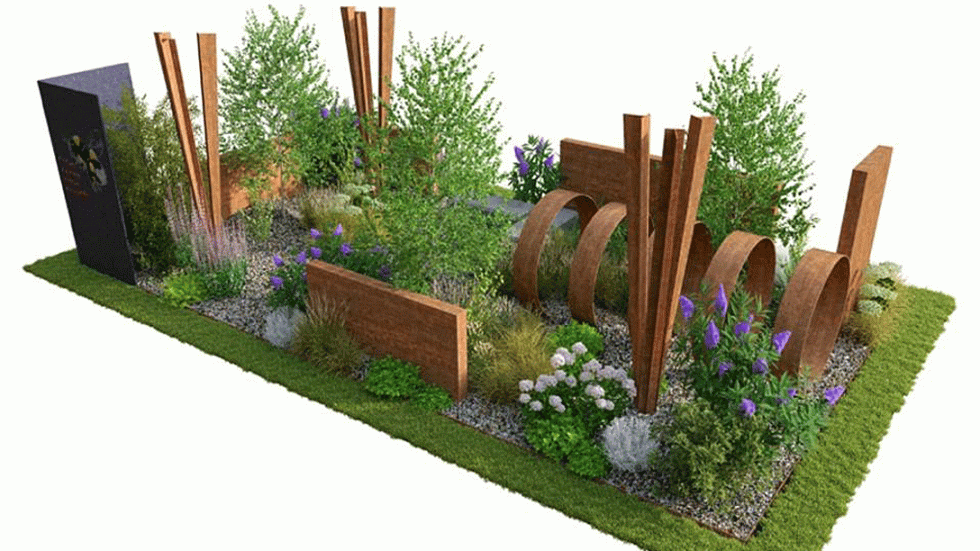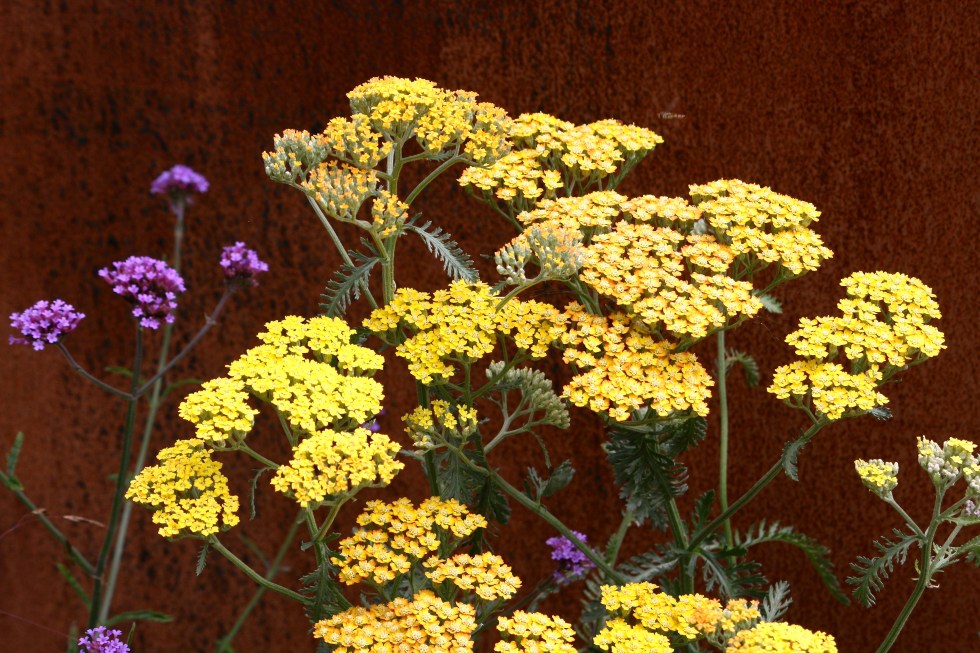I’m very aware that I am not opening my Hampton Court coverage with classically beautiful gardens. In my quest to offer the fullest overview possible, I rarely get around to detailing my favourites, which was certainly the case last year. So this year, instead of starting with a lengthy perambulation around the showground, which I have offered on my Facebook page, I am beginning with those gardens that most captured my imagination. Today’s offering may not do it for you, but others this week surely will.
You may have seen enough of Corten steel in show gardens – I certainly thought I had – but Brownfield Metamorphosis, designed by Martyn Wilson, made me think again. Regeneration specialist St Modwen commissioned this garden to highlight its role in creating thoughtful public open space on brownfield sites. The designer sought to celebrate the period in between demolition and reconstruction when nature moves in, creating a temporary landscape and often encouraging wildlife to move in. He cites New York’s High Line Park and the old MG Rover site in Birmingham among the locations that inspired him: “They invite the public into what was a dangerous and forbidden space, into what is now a work of art, representing the centre of their respective communities.
Concrete blocks, typically employed as barriers to prevent humans and vehicles from entering a building site, are repurposed here as seats. I especially enjoyed the contrast of tactile Pilosella aurantiaca (fox and cubs) against the sun-bleached, composite surface. Ledbury-based sculptor Simon Probyn, who works with recycled steel, created the monolithic steel structures that demarcate the corners of the plot. These brutal forms are softened by grasses and umbels; garden-worthy varieties of plant groups that are often pioneers of derelict sites.
My favourite structure is the sequence of rusted steel hoops part buried in rubble. This is a device which could be used in a gravel garden or perennial border to create structure, shade and interesting shadows, or, in open space, for children to scramble through.
Martyn Wilson points out that sites destined for regeneration are often hoarded, with the community making their mark by way of street art. On a section of hoarding reclaimed from a regenerated site at Etruria Valley in Stoke-on-Trent, Artist Louis Masai has painted a striking bee threading a needle, representing the pollinator’s vital role in the survival of ecosystems. Great work, but something about the positioning of the painting, or the amount of hoarding, made it feel divorced from the rest of the garden.
Whilst not a garden one might wish to recreate in its entirety, it is both an accurate representation of a brownfield site and a space packed with ideas one could incorporate into a small garden. I’ve already referenced the steel hoops, but why not use recycled concrete forms as seats, benches or retaining walls? They’d be cheap and, softened by planting, not nearly as austere as one would imagine.
A rusted bowl filled with water might attract birds and hedgehogs into the garden, whilst buddleja cultivars, such as the fulsome B. ‘Wisteria Lane’ used here, are butterfly magnets. Deep, rough gravel ought to inhibit weeds and provide a more permeable surface than paving, thereby reducing run off and the risk of flooding. Herbs such as thyme, fennel and oregano flourish in such an enviroment.
Of course, brownfield sites are ephemeral landscapes – unstable, changing, fleeting habitats. Maintaining a garden like this would require careful maintenance to prevent it from reverting to an ugly mass of tangled undergrowth. Yet, well tended, and on a sunny day, I can imagine myself enjoying the warmth of the rough concrete, the drama of the steel structures and the hum of bees foraging among the flowers. My drink of choice in such a setting? It could only be a Rusty Nail. TFG.
Plant List
Trees and Shrubs
- Betula pendula
- Buddleja davidii ‘Wisteria Lane’
- Rubus cockburnianus
Perennials and Herbs
- Achillea ‘Walter Funcke’
- Achillea ‘Moonshine’
- Achillea ‘Terracotta’
- Alchemilla erythropoda
- Alchemilla mollis
- Artemesia vulgaris
- Erigeron karvinskianus
- Foeniculum vulgare ‘Purpureum’
- Geranium robertianum ‘Bill Wallis’
- Knautia macedonica ‘Mars Midget’
- Leucanthemum x superbum ‘Snow Cap’
- Leucanthemum x superbum ‘T.E. Killin’
- Lychnis coronaria ‘Alba’
- Lychnis coronaria ‘Mese’
- Origanum vulgare
- Pilosella aurantiaca
- Verbena bonariensis
Grasses
- Briza media
- Deschampsia cespitosa
- Deschampsia flexuosa
- Festuca amethystina
Ferns
- Asplenium scolopendrium
- Asplenium trichomanes
- Dryopteris filix-mas
Categories: Flower Shows, Flowers, Foliage, Garden Design, Hampton Court Flower Show, Perennials, Planting Design, Plants, Small Gardens, Wild Flowers













I am beginning to understand the new gardens. Yes why not make the most of what is already there, concrete, iron and incorporate in a new aesthetic or old.
I used old tables, cracked mirrors, old iron fences that created interest and variety.
So much goes to waste doesn’t it? I try to reuse and recycle whenever I can. Glad you got something from this garden Eric.
Thanks for this post – I had hoped you’d write about this garden. I had a look at the RHS Hampton Court Flower Show website and from what I saw there, this was one of my favourites. Reminds me a lot of Derek Jarman’s garden. Not something I would deliberately attempt to create in my own plot, but – making the most of what a “hostile” environment (from a traditional gardener’s point of view) has to offer – it has a wonderful aesthetic all of its own.
Wonderful pictures, as usual! Oh, and I’d never heard “fox and cubs” before: seeing the accompanying pic I can’t help but admire the name – how apt!